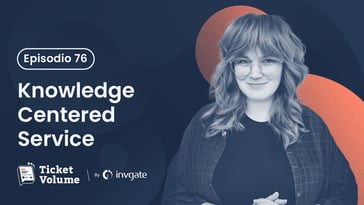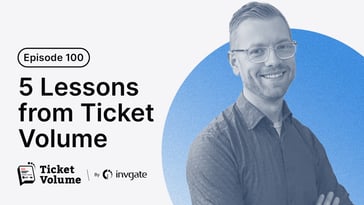In a world where companies are embracing the power of collaboration with multiple service suppliers, the question arises: How can they transform this diversity into a harmonious service ecosystem? The fact of the matter is that unlocking the true potential of collaboration is easier said than done, but once it’s out of the way, organizations are guaranteed to adapt faster and more efficiently to changes in the IT industry.
Claire Agutter sheds light on the fundamentals and advantages of working with sourced services on the 32nd Episode of Ticket Volume, our IT podcast. She explored the benefits of adopting a Service Integration and Management (SIAM) approach to effectively manage services and gave practical advice on how to go about it.
Agutter currently holds the position of Director at ITSM Zone and Scopism. With her extensive expertise, she serves as a trainer, consultant, author, and Chief Architect for VeriSM. Her contributions to the industry have been widely recognized, earning her the distinction of being named an HDI Top 25 Thought Leader in both 2018 and 2019. Additionally, she was nominated as one of Computer Weekly's 50 Women in Tech, further highlighting her significant impact in the technology sector.
But this is just a short recap. Don't miss out on the chance to watch the entire episode to gain valuable insights into navigating the complexities of a multi-supplier environment. Register now for our monthly live recordings and get in on the action. You can actively participate, ask questions in real-time, and dive deeper into the content. It's a great opportunity to engage with us on a whole new level.

Organizations want to manage service effectively
Agutter mentioned a shift in organizations' adoption of SIAM from Scopism (it stands for Service Integration and Management, focusing on sourcing services effectively) since the beginning of the COVID-19 pandemic. This is because they have evaluated their supply chains and identified weaknesses and strengths. And for that, SIAM is now seen as a great fit for managing services and suppliers effectively.
SIAM is witnessing advancements in governance, automation, robot workers, and artificial intelligence (AI). They emphasize that the industry is evolving rapidly, with new learnings every day.
For instance, Agutter discussed the significant savings achieved through automation in terms of time and money. And how automation eliminates jobs that are no longer necessary, such as password resets, meaning that they no longer require human intervention.
What you want to avoid is a swivel chair entry situation, which refers to a state where an IT service desk agent or operator needs to manually switch between different systems or tools to complete a task. This manual back-and-forth movement resembles someone swiveling in their chair to access different resources. Swivel chair entry can be time-consuming, error-prone, and inefficient.
SIAM, on the other hand, is an approach to managing multiple service providers and integrating their services to provide a seamless end-to-end service to the customer. It focuses on coordinating and orchestrating the delivery of services from various internal and external service providers, ensuring that they work together effectively.
Our guest speaker also shared the challenges and benefits of adopting this outsourcing service model thanks to data obtained via survey. It showed that most organizations are working with a large supply network and need appropriate management strategies.
Additionally, sourcing trends have varied over the past decade, with younger people getting involved. Also, the survey revealed that smaller companies are sourcing more, while larger companies may source less for competitive advantage. This is because sourcing has received a bad reputation due to communication barriers, quality issues, and delays caused by miscommunication.
Regardless, there is a growing realization among sourcing providers that quality is crucial. She mentioned a concept called "Matchmaker for sourcing" where finding a culture fit and vendors who truly partner with.
The integration of sourced services and realizing their benefits is a crucial aspect. Agutter’s observations along the way point out what aspects are important when it comes to managing services. These are her main considerations:
Getting started with sourcing
These are some of her tips on how a company that traditionally used its own service desk resources can get started with sourcing:
- Start by having a rough idea of what you want, including 24x7 cover, budget, volume, and attitude
- Evaluate different suppliers and visit their facilities to assess their approach and culture
- Look for flexibility, openness, and transparency in the supplier's operations.
- Consider the benefits of outsourcing for scalability and cost-effectiveness
She also emphasized the significance of attitude when outsourcing service desk operations. First and foremost, a small business should avoid a service desk constantly questioning decisions or seeking approval. But as well,
- Choose a vendor that encourages open communication and collaboration.
- Empower service desks with the authority to make decisions within budget limits.
- Minimize escalations by fostering a comfortable working environment.
Agutter highlighted the advantages of outsourcing for small businesses. For instance, small businesses may not have the resources to run a 24x7 in-house service desk effectively.
Outsourcing allows access to fractional resources based on specific needs. Specificity means that quality can be maintained through careful vendor selection and collaboration. Yet, the success of outsourcing depends on both parties building trust and maintaining a positive culture.
The Director of Scopism remarked on the importance of building collaborative relationships in outsourcing. A high-trust environment leads to positive outcomes and better service delivery. Therefore,
- Approach the relationship with a mindset of improvement and working together.
- Focus on understanding each other's needs and finding ways to enhance collaboration.
- Both the vendor and the customer need to contribute to building a healthy relationship.
"There's a lot of work being done in the SIAM space as well about looking at the very foundations of a relationship because if the contract is written so that your vendor gets paid for closing tickets, your vendor's gonna focus on closing tickets. (...) For me a big thing at the moment is outcomes, let's not measure people on the number of tickets, time to answer."
Claire Agutter
Director of Scopism and ITSM Zone
Episode 32 of Ticket Volume
E-learning to approach customers
E-learning can be utilized as a tool to train and educate employees or service desk agents who are involved in the outsourcing of service desk operations. Agutter and her team discovered customers from various corners of the globe who were eager to share their insights and recommendations on e-learning. Their objective was not only to gather feedback but also to offer valuable information to fellow learners.
|
|
"We have lots of quantitative data, we have pass rates, we have completion rates… We can look at what people are engaging with actually within the software, but that human element is still so important, so we've had the feedback survey embedded within our classes for years. We wanted to actually get a little bit closer to our customers." Claire Agutter |
One corporate client has a two-day offsite training where employees need to complete the course within that time frame, which is not ideal for effective e-learning. On that note, Agutter talked about the study tracker document they create for each course. It includes lessons, exercises, study guide length, and estimated completion time. Although they don't receive feedback on it, some customers have expressed appreciation for the study tracker.
Beran and Agutter went on the importance of sharing feedback and learning in smaller chunks as a way to allow other customers to hear how others apply what they've learned.
Different people have different learning styles, and some will always prefer a classroom setting. Making people aware that e-learning is not just a virtual classroom leads to better results.
Bottom line
This is just a summary of Ticket Volume's episode featuring Claire Agutter, but there's a lot more to discover in the recording. Be sure to listen to the full conversation with Matt Beran to know what is Service Integration and Management (SIAM), and how to manage services.
You can find the full episode on popular platforms like Apple Podcasts, Spotify, YouTube, or any other podcast platform you prefer. Remember to subscribe if you're interested in joining the monthly live recordings!















